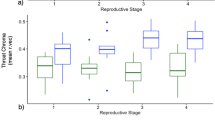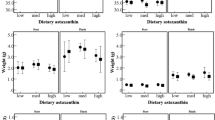Abstract
Female three-spined sticklebacks (Gasterosteus aculeatus) are suggested to select mates based on their red nuptial coloration, males with a redder display being more preferred. Although there are both laboratory and field data to support this view, there are also published accounts where females do not show a preference for the redder male. Here we report the results of a series of 19 trials where receptive gravid female three-spined sticklebacks were allowed to choose between two size-matched rival males. We used photographic and image analysis techniques to quantify male nuptial coloration to investigate how the magnitude of the colour difference between the two alternative males influenced female preferences. Using the amount of time a female spent oriented towards each male as a measure of his attractiveness to her, females were not always found to select the redder of the two presented males. We did, however, find that that the relative difference in coloration of the two males in each pair was important in determining the level of coloration-based preference, with females only selecting redder males consistently when the difference in coloration was sufficiently large.
Similar content being viewed by others
Author information
Authors and Affiliations
Additional information
Received: 26 October 1999 / Received in revised form: 10 January 2000 / Accepted: 13 February 2000
Rights and permissions
About this article
Cite this article
Braithwaite, V., Barber, I. Limitations to colour-based sexual preferences in three-spined sticklebacks (Gasterosteus aculeatus). Behav Ecol Sociobiol 47, 413–416 (2000). https://doi.org/10.1007/s002650050684
Issue Date:
DOI: https://doi.org/10.1007/s002650050684




